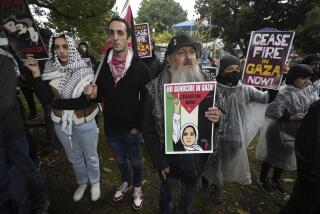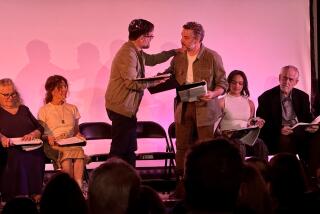Faith and Rage Intersect at Jerusalem Holy Site
JERUSALEM — For his first visit to Judaism’s holiest site, Daniel Kaszovitz took a ritual bath before setting out this week, cleansing himself of impurity. He wore a skullcap on his head and sandals on his feet, in keeping with a religious prohibition against leather shoes on holy ground.
Then he and several neighbors from a Jewish settlement in the West Bank climbed a chewed-up dirt ramp overlooking the Western Wall and stepped onto the Temple Mount, an open-air plaza high above this ancient city.
For Kaszovitz, 33, the visit was fraught with personal significance.
“This is the first opportunity I’ve had to come up here,” he said. “It’s very moving.”
But the visit was also fraught with tension, in a place where holiness and explosive anger often intersect.
The site is revered by Jews as the spot where their first and second temples stood, but the 36-acre plaza is also sacred to Muslims, who are the custodians of the site and call it the Noble Sanctuary, the place where Muhammad ascended into heaven for a glimpse of the divine.
Their competing claims have turned the plateau into one of the most contentious patches of real estate on Earth, a symbol not only of two age-old faiths but also, to many, of Israeli and Palestinian national aspirations.
Three years ago Sunday, then-opposition leader Ariel Sharon paid a visit to the mount to assert Israeli claims to all of Jerusalem. The visit sparked riots that eventually coalesced into the ongoing Palestinian uprising, which is known as the Al Aqsa intifada after one of the sanctuaries on the site. For most of the last three years, the compound was closed to non-Muslims by the Islamic trust that maintains it.
But not anymore. This summer, the Israeli government decreed the limestone plaza open to visitors once again.
And once again, passions are inflamed.
“This is Muslim! This is Muslim!” guardians of the Al Aqsa mosque shouted as Kaszovitz and about 30 others -- some his neighbors, some from another group -- stood in the mosque’s shadow last week. They were on a tour being guided partly by Yehuda Etzion, a Jewish extremist who went to prison in the 1980s for plotting to blow up the mosque.
Israeli police in dark blue flak jackets swiftly converged on the scene. So did several Muslim men, who came running to protect the mosque from what they regarded as disrespectful encroachment by religious Jews, although most of the visitors were standing around quietly.
There were shouts, and some shoving. A barefoot young Jewish man accused of publicly praying -- strictly forbidden for Jews on the site -- was hustled away, while police pushed back the rowdy Palestinians, some of whom muttered curses and pointed fingers in the visitors’ faces.
For the rest of the hourlong tour, as they strolled beneath the olive and cypress trees that line the plaza’s perimeter, the Jews were trailed -- and sometimes surrounded -- by a bevy of security officers and Muslim worshipers. Several times, confrontations erupted, each side blaming the other for starting it.
For Harold Dershowitz of New Jersey, whose daughter lives in the same settlement, Alon Shevut, as Kaszovitz, the clashes between his tour group and the Muslims reinforced his reasons for making the pilgrimage.
“If we didn’t do it, we’d lose it. Clearly these people think they own the place,” said Dershowitz, 58.
“It’s absolutely vital” for Jews to visit the Temple Mount, he added. “It’s part of reclaiming the land. That’s what I’m trying to do.”
That’s also precisely what Muslims fear. With the general reopening of the plaza, many Muslims charge that a plot is afoot to drive them from their third-holiest site, behind only Mecca and Medina in Saudi Arabia.
The Israeli government contends that it is simply restoring the situation that prevailed before Sharon -- who is now prime minister -- visited three years ago.
Then, thousands of tourists trudged up to the plaza every day, including Jews and Christians.
Far fewer make the climb now, reflecting a precipitous drop in tourism throughout the Holy Land. A busy day might mean about 250 visitors, who are restricted to morning hours and limited time in the afternoons on Sunday through Thursday.
Most visitors appear to be tourists, some of them secular Jews, whose presence causes no incident as they wander the plateau, admiring the spectacular view and the two ancient Muslim sanctuaries, Al Aqsa and the golden-topped Dome of the Rock, which dominate the Jerusalem skyline.
But Adnan Husseini, the head of the Waqf, or trust, that maintains the compound, said the situation is different than before Sharon’s visit. He said a larger proportion of visitors are religious Jewish settlers, many of whom embrace an ideology of “redeeming” land they believe was given to them by God, including all of Jerusalem and the West Bank.
“Now they allow 30, 40, 50 settlers in at a time. This is new,” Husseini said. “And this gives them some power. The settlers can start doing religious activities.... It is very provocative for us.”
Muslims cite a recent statement by settler rabbis encouraging followers to visit the Temple Mount, while Israeli authorities routinely ban Palestinian men younger than 40 or from the West Bank from attending Friday prayers on the site.
Many observant Jews obey teachings that prohibit setting foot on the plaza because they might tread on the Holy of Holies, the temple’s inner sanctum, where the divine presence is said to have dwelt. One ultra-Orthodox rabbi recently labeled Jews who ascend the mount “wicked persons” deserving of “death by the hand of God.”
But the settler rabbis disagree. On Sept. 3, they reaffirmed in more urgent terms one of their previous rulings, which said that archeological evidence allows Jews to walk on parts of the plateau, mostly along its outer edge, without defiling sacred places.
“When we refrain from ascending, we are announcing to the world that -- heaven forbid--we do not have any part in God’s mountain and reinforcing the feeling among the Arabs that the Temple Mount is theirs,” the rabbis warned. “It is a disgrace for us that the Arabs say, ‘We will inherit God’s oasis,’ and tens of thousands of Arabs go up the mountain while we do not go up there.”
Muslim fears were further stoked by the announcement last week that Israeli police had uncovered a plan by Jewish militants to blow up a number of Muslim mosques and shrines in the course of a single day, including Al Aqsa and the Dome of the Rock. Some Jews believe that by doing so, a third temple can be established and the messiah’s arrival hastened.
“The Israeli elements that are interested in displacing the Muslims on the mount are an incredibly fringe element,” said Gershom Gorenberg, the author of “The End of Days: Fundamentalism and the Struggle for the Temple Mount.” “On the other hand, they exist, and their very presence feeds Muslim fears that Israel as such has designs on displacing the Muslims.”
In fact, it was Israel that turned the site back over to Muslim custodianship after capturing it from Jordan in the 1967 Middle East War.
“The Temple Mount is in our hands,” Lt. Gen. Mordechai Gur famously declared after seizing the site, but the next day, then-Defense Minister Moshe Dayan handed the keys back to the Waqf, which many scholars consider a politically astute move to lessen religious tensions.
Since then, official Israeli policy has been to forbid Jews from praying on the site, a ban enforced by Israeli police.
“Most of the people go up and look around, but if we think there’s going to be a problem, we keep an eye out,” police spokesman Gil Kleiman said. “A Jew who tries to go up there to pray will be forcibly removed.”
Despite the tight security, sporadic violence has broken out since Israeli authorities began gradually reopening the compound to non-Muslims beginning in July. There was talk that the Waqf had secretly agreed to the move, but Waqf officials say Israeli officials imposed the reopening on them.
This month, police ejected at least three Jewish visitors who either provoked Waqf guards or tried to pray.
Officers also used tear gas to break up a demonstration by hundreds of Palestinians, who protested Israeli threats to expel Yasser Arafat by raining stones onto Jewish worshipers at the Western Wall.
“Those small incidents ... underline the fact that the essential volatility is still there,” Gorenberg said. “At least until there’s a negotiated agreement ... it’s going to be a volatile site.”
To Muslims, the fact that someone like Etzion, the convicted Jewish militant, is allowed onto their Noble Sanctuary feels like an aggressive act.
Two years ago, Etzion and other radicals tried to storm the compound before police beat them back. Etzion said at the time that “the mosques will not stay on the Temple Mount, and the third temple will stand here.”
He now leads tours of the site, although last week, the group from the Alon Shevut settlement had not expected to be lumped together with Etzion. The police decided to combine the two groups and escorted them up at the same time.
Ruthie Lieberman of Alon Shevut, which lies halfway between Jerusalem and the West Bank city of Hebron, confessed to being “a little nervous” as she walked around, the tension palpable in the air.
But she felt awed as well.
“Look around at where we are,” Lieberman said. “This is not Disneyland. This is real.”
She said she respected Muslims’ reverence for the plaza but was disturbed that “this is not mutual.”
Many Israelis have been offended by claims by some Palestinians that the Jewish temples never stood on the site.
Kaszovitz expressed frustration at not being allowed a moment of private communion with God, lest the police or the trailing Muslims take him to task.
“I’m not yelling, I’m not blaring anything on a loudspeaker above the city. This is a very personal experience,” he said.
He declined to say whether his own vision for the plateau included other faiths that hold the site sacred.
But as another ruckus erupted between Muslims and members of his group, he said dryly, “This certainly is not my vision.”
More to Read
Sign up for Essential California
The most important California stories and recommendations in your inbox every morning.
You may occasionally receive promotional content from the Los Angeles Times.











